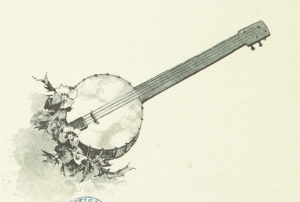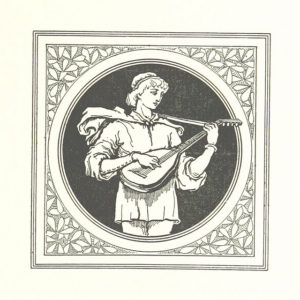Music is an integral part of the culture at St. Martin’s Academy, and specifically two forms of music are fitting for this Catholic boys boarding school. First, since the school is Catholic it presumes that the liturgy—Mass and the Divine Office—are prayed in common. Therefore, some type of sacred music should be in place to accompany these actions. In the secular sphere, given St. Martin’s unique program, boys live in community, work in the fields, gather around the hearth, and live as brothers. Traditional folk music is a uniquely fitting companion to all of these activities as we shall see. I would like to offer some thoughts on these types of music and their fittingness to life at a Catholic boys’ school.
Sacred Music
The scriptures are filled with references to song. If one examines them, it does not take long to discover a theme running throughout, namely, that in the scriptures, music is active. It is something we do, and we do primarily for the LORD. It is how we, collectively, as the Church communicate with the divine. Therefore, at a school like St. Martin’s Academy, boys will learn music first and foremost for the liturgy.
In Sacrosanctum Concilium, the first document of the Second Vatican Council, the council Fathers articulate some of the criteria which ought to be used when considering sacred, liturgical music. They write, “sacred music is to be considered the more holy in proportion as it is more closely connected with the liturgical action, whether it adds delight to prayer, fosters unity of minds, or confers greater solemnity upon the sacred rites” (SC 112). In other words, not all liturgical music is created equal. Looking to the musico-liturgical patrimony of the West, we can see that both Gregorian chant, and sacred polyphony have endured and are treasured by the Church. Therefore, it is most fitting that boys at a Catholic boarding school become familiar with these forms of music, not only for their historical and musical value, but also for their proportional sanctity to that of other musical forms. The following are a few brief reflections on how chant and polyphony fill the above criteria.
“sacred music is to be considered the more holy in proportion as it is more closely connected with the liturgical action, whether it adds delight to prayer, fosters unity of minds, or confers greater solemnity upon the sacred rites” (SC 112).
- Connected with the Liturgical Action. At a Catholic boarding school, boys ought to be steeped in the tradition of the Church; an immersion which extends to sacred music. Boys ought to learn to sing together, and make their voices as one through Gregorian chant. Having learned to listen to each other, polyphonic motets should be added to the repertoire for liturgical use. One reason for this is their connection with the liturgical action. Unlike many hymns, which can sometimes feel artificial, or jarring to what is going on at the Mass, chant was written specifically for the liturgy, and therefore there is somewhat of an organic relationship between the music and the liturgical action. This is why the Council Fathers at the Second Vatican Council acknowledged “Gregorian chant is specially suited to the Roman liturgy: therefore, other things being equal, it should be given pride of place in liturgical services” (SC 116).
- Adds Delight to Prayer & Fosters Unity of Minds. Anyone who has experienced skilled monks chanting the Divine Office, or a Palestrina motet in a church with the right acoustics knows the mystical delight mentioned here. It inspires a profound, contemplative silence which, to risk sounding overly romantic, lifts up the soul, and for a moment brings it to the edge of the divine present. It is a stillness unlike any other. In this stillness, there is also an acute awareness of those around oneself. It is a feeling hard to describe, like an awareness that we have all experienced something together, beyond and above ourselves. It is an appropriate feeling, because it points to the reality of what is going on in the liturgy.
“Gregorian chant is specially suited to the Roman liturgy: therefore, other things being equal, it should be given pride of place in liturgical services” (SC 116)
- Confers Greater Solemnity Upon the Sacred Rites. A Byzantine Catholic priest once told me, when explaining the extensive use of chant in their liturgy, that in the bridal chamber, the bride does not speak, but rather sings to the bridegroom. This image has stuck with me because of the profound truth it expresses. What is the Mass other than the intimate meeting of the Church, the Bride of Christ, with her bridegroom, Jesus Christ? This intimate meeting is also the highest calling of man, and thus, since man is both soul and body, the material should reflect the spiritual. Therefore, everything in the liturgy ought to reflect the highest parts of man, including the music.
Traditional Folk Music
When forced to abandon their ship, The Endurance, trapped in the ice off the coast of Antarctica, Shackleton made only one exception to his two-pounds-per-person rule: Leonard Hussey’s 12 lb. banjo. The reason for this is that Shackleton knew that keeping up the morale of his crew was necessary for survival, and that music would prove to be “vital mental medicine” for everyone in the months of harsh survival which lay ahead. Just as it was for the crew of The Endurance, music is vital in keeping keeping morale up in a boarding school. It is important, however, that music serve a greater purpose than simply to mask the background silence. This music ought to be something which wells up from within, as opposed to something which is artificially consumed. Therefore, I offer the following points on why traditional folk music fills this need in a unique way at a place like St. Martin’s Academy. 
- Folk music teaches the students that music is not simply something for passive consumption. Regardless of a boy’s religious upbringing, he is at least somewhat aware of the fact that people sing in church. What he may not be accustomed to is a world where music is homemade and not mass produced and prerecorded. Consistent with our emphasis on placing the boys in contact with reality, at St. Martin’s, if a student wants to listen to music, he cannot withdraw from the world into his headphones, rather he must do the opposite. He must sing out into the world. This is much more difficult. It requires a confidence in relation to the world around oneself. It requires a knowledge of the song itself. One does not need to know the lyrics of a song to listen to it, but he does in order to sing it! He must learn the music, ideally not from something, but from someone, which leads to point number two.
- Folk music opens one up to a living, oral tradition. This is something which distinguishes folk music from other forms of modern popular music. Unlike popular music, traditional folk songs do not have a definitive voice or “version.” Their source is usually unknown, or so distantly removed that it is a matter of little consequence. Thus, folk songs require individuals to give them a voice. Popular, recorded music has a specific, definitive voice against which all other versions of the song must be judged for their fidelity. Folk music does not have this limitation. As with oral tradition, one learns a song from another person, and makes it his or her own. The song then gets passed on to another who in turn makes it his own, and so on. Thus, performing folk music is less “covering” another’s song than it is being a steward of a tradition that features some of humanity’s richest stories . With this understanding, one develops a sense of responsibility to carry the torch, giving voice in the present to the songs of the past. This leads us to our third point.
- Folk music not only connects us to tradition, but it is equally “ever new.” The tradition of folk music is a living tradition, and, as with all living things, it is constantly in a state of becoming. Since folk songs tend not to have a specific point of reference (unlike pop music), there is not necessarily a correct, or incorrect way of playing a specific song. Thus, the folk tradition is always evolving. For example, Gillian Welch and David Rawling’s song “Wind and Rain” tells the same story as the Pentangle’s “Cruel Sister.” Neither one of these could be considered more correct than the other. They simply show the differences that are bound to develop over time in oral tradition. Thus, while there is a responsibility with regard to stewardship, there is also a significant amount of freedom when interpreting and giving a unique voice to the songs of the tradition, making them new to the world again. Playing traditional folk music is a delicate balance of preservation and innovation.
As part of the rich fabric of life at St. Martin’s, music is woven throughout each day. Whether chanting responses at a High Mass, flatpicking around the hearth, or intoning Compline, the music is made by the boys, but also contributes to making them active members of a tradition much greater than themselves; and one that calls them toward greatness. 

